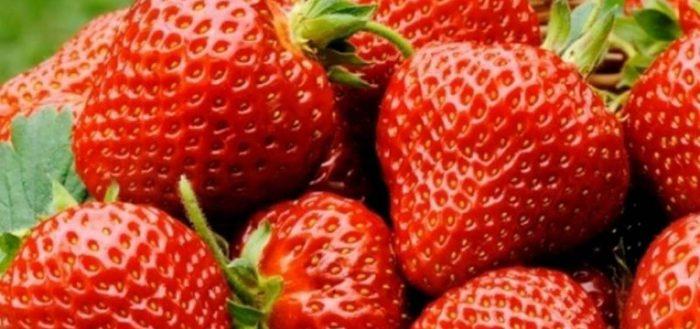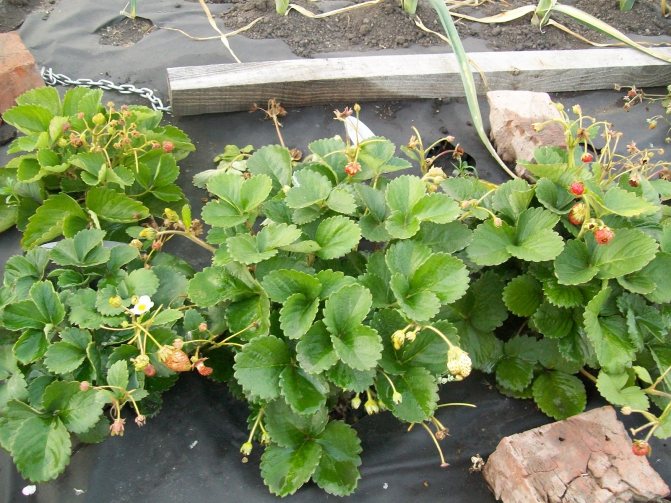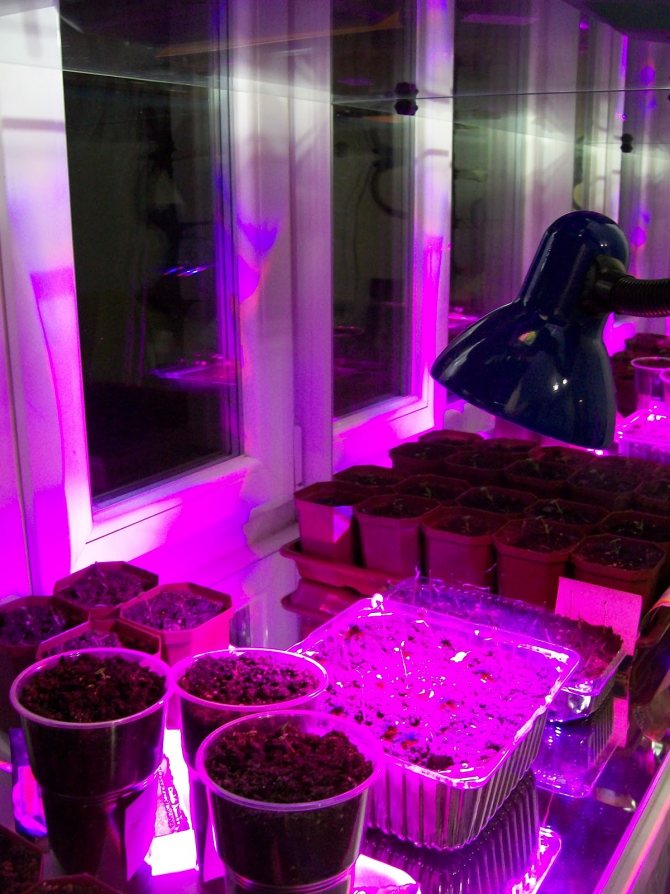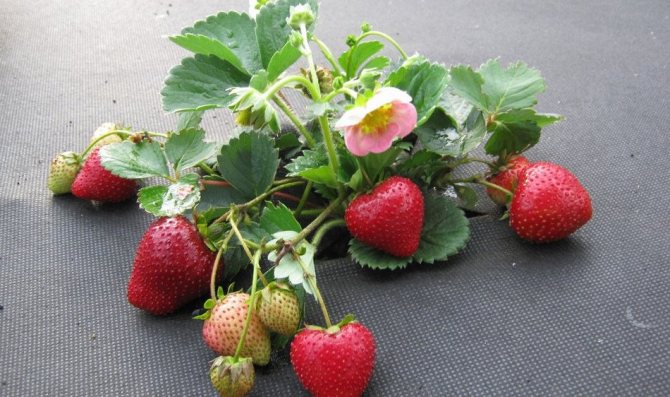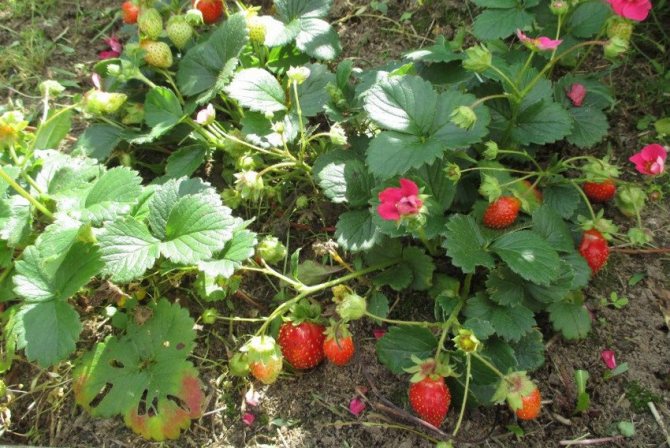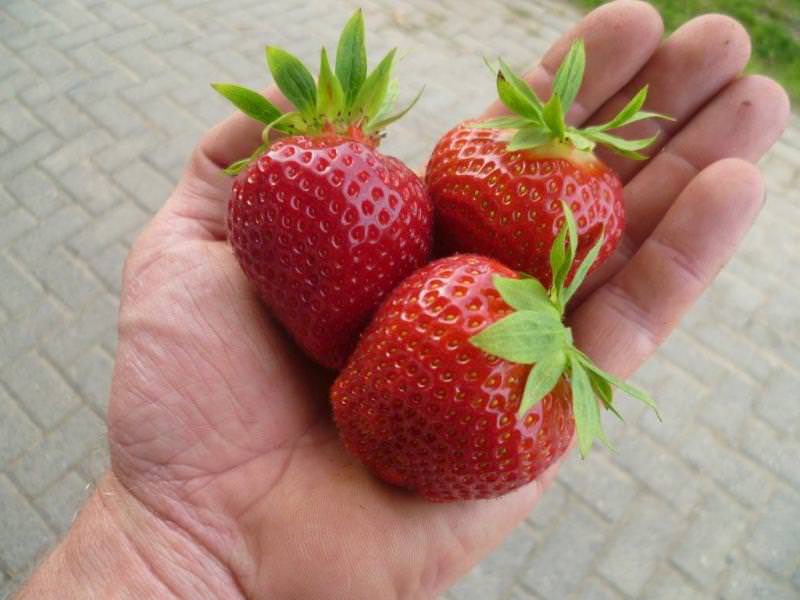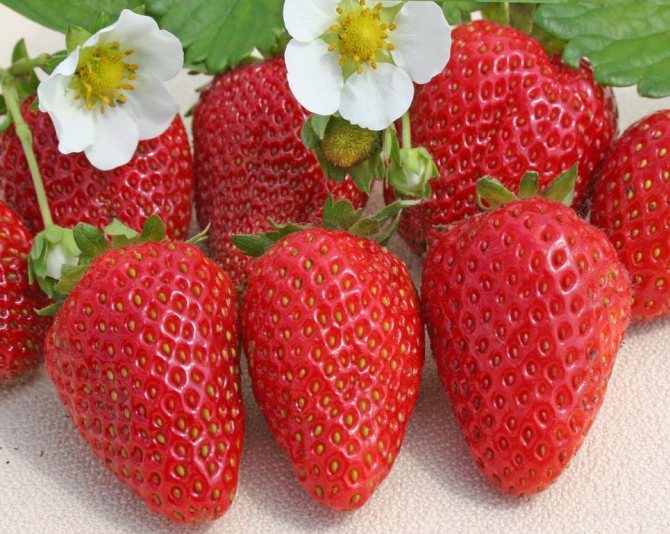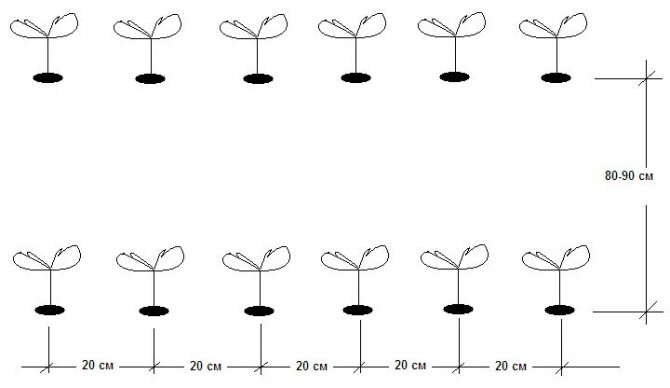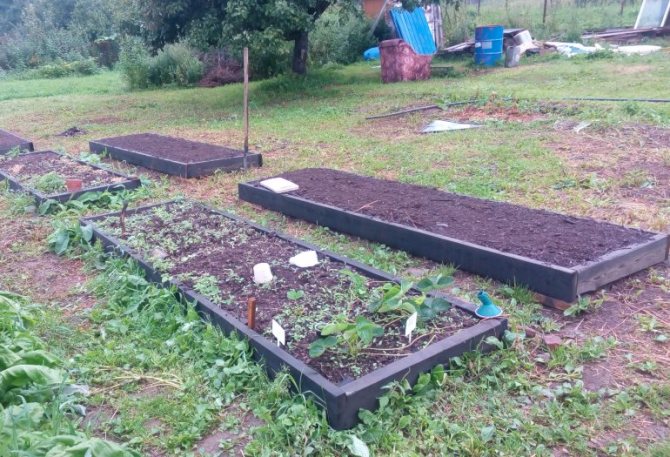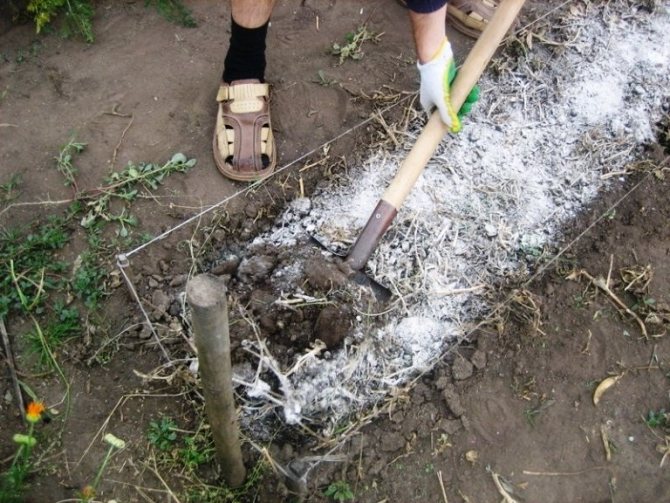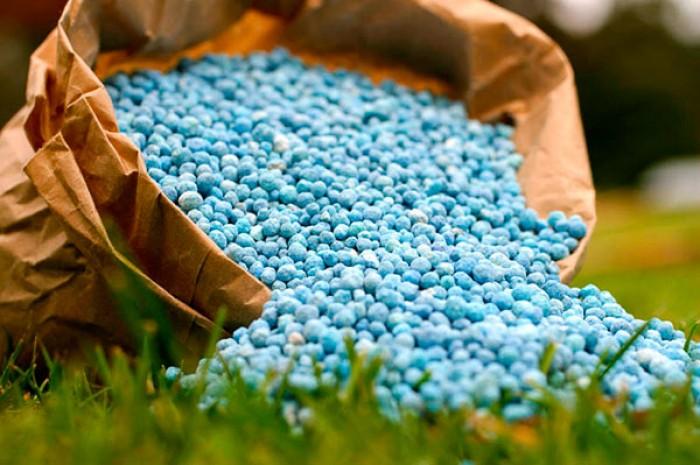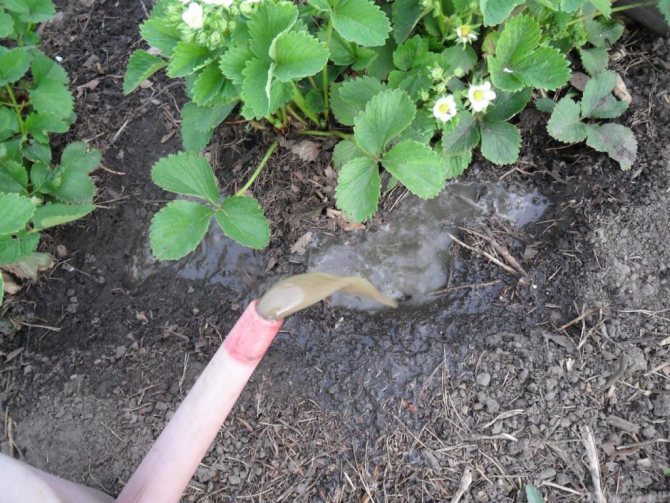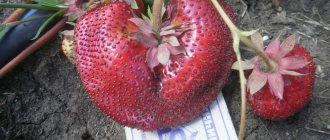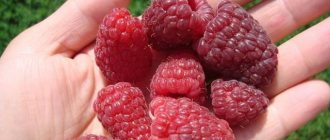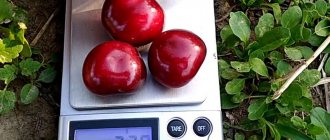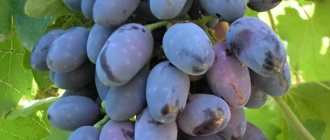Origin
This berry is an English aristocrat: it was in Britain, at one of the experimental stations, by crossing two other varieties, a new one was bred, called Florence. It happened exactly twenty years ago. By the way, sometimes they confuse and call the berry Florence, but this name is fundamentally wrong. By combining varieties, scientists sought to achieve the ideal taste, aroma, and stable immunity of the berry. They succeeded in this to the fullest - it is for this reason that many gardeners prefer the above variety.
Strawberry Florence: characteristics
The variety is dessert, late and high-yielding - with good, proper care, you can remove up to one to one and a half kilograms of berries from one bush, and up to thirty-five tons from a hectare. Florence ripens in the middle of summer - at the beginning of July, when other types of strawberries, as a rule, are already leaving. The berries are medium in size and weight - in total about fifty grams, the skin and flesh are firm.

The main feature of this variety is the ability to actively bear fruit for five consecutive years, each year still giving a rich harvest. It can also be noted that Florence strawberries are quite resistant to various kinds of lesions and diseases, they take root well both in the open field and in a greenhouse, and do not require special care. The strawberry mustache is strong, they, as already mentioned, are few, respectively, it is not difficult to care for the garden bed. Another of the advantages of Florence is that it is easy to propagate, it is frost-resistant (withstands up to minus twenty) and it feels quite comfortable, if not in all, then in most regions of Russia, even with a humid climate. Stored for a long time, it is recommended to use for jams and preserves. If you freeze a berry of this variety, its taste will not change.
Of the minuses, it is worth noting the high demands on the presence of moisture, since without a sufficient level of water in the soil (especially in the heat), the plant reduces productivity. Also, the berry should be constantly ventilated, and with an excess of moisture, during the rains, it can get sick.
Landing rules
Growing British Florence strawberries is quite simple and even a beginner gardener can handle it. However, strawberry care is not the only thing to observe. It is also important to properly approach the planting of garden strawberries.
On one site, Florence grows normally for 4-5 years. In the future, it is advisable to transplant strawberries.
It is best to plant strawberries in the evening or early morning when the sun is inactive.
You can plant strawberries in both spring and summer. Planted strawberries in the summer (early August) will already yield the harvest for the next season. If you plant seedlings in the spring, then you will be able to get a crop only next year.
Before starting planting work, you need to choose the right site:
- It should be sunny.
- Sheltered from the north winds.
- Fertilized.
- Weed-free.
Prepare the site approximately 6 months before the start of planting work. All weeds are removed from the site, they are dug up to saturate with oxygen and loosened, and also fertilized with organic matter.
The very same planting scheme is as follows:
- The first step is to pull out holes on the site. They should be shallow, about 15-20 cm. The diameter of the hole is about 25-30 cm.
- A distance of 40 cm is left between the holes, and 60-70 cm at all between the rows. Long distances will allow you to take care of strawberries without problems and easily harvest.
- Each hole is watered abundantly with water.
- After the water is absorbed, a seedling is placed in the hole. It must be planted so that the root system is in an upright position. Experienced gardeners recommend forming a small mound in the center of the fossa, along which it will be possible to straighten the roots of the bush.
- After the seedling is placed in the hole, it is sprinkled with soil and tamped.
- At the end of planting work, the hole is watered with water, approximately 1 liter per 1 plant.


Strawberry Florence: planting and care
It is best to plant strawberry bushes in spring or at the very beginning of summer, while it's not bad if you can guess and do it in cloudy, cool weather. Of course, before lowering the plants into the ground, preparatory work should be carried out: about a month before the "X-hour", it is necessary to carefully dig up the soil in the future bed and add fertilizers - humus or compost (so the soil will become looser, which is exactly what is required for strawberries). It is imperative to dig up all the weeds and collect the trash. Wells for Florence should be made exactly according to the size of the roots of the plant, before planting it, they must be thoroughly moistened with warm water.
It is necessary to place Florence strawberries in the garden every 30-40 centimeters from each other. Covering a bush with earth, you need to make sure that it does not fall on the heart or the main kidney. By the way, Florence will take root well both in the open field and in the greenhouse. In the second case, she will give an earlier harvest.
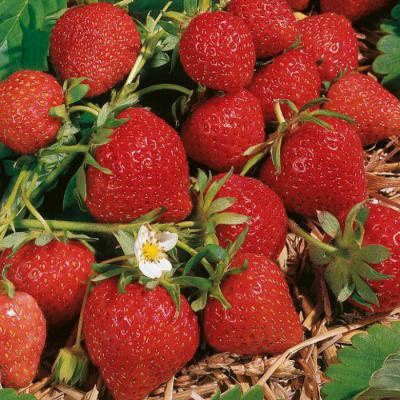

Proper care of the Florence strawberry variety (pictured) according to the description and reviews involves periodic loosening of the soil, watering and feeding the plant. Loosening is carried out throughout the summer period, but at a shallow distance. It is imperative to add three kilograms per square meter of humus or compost. In extreme heat, the plant may be unwell - to protect it, it is permissible to cover it with something. It is also necessary to cover strawberries for the winter - agrofibre or peat is perfect for this purpose (especially important in cold regions). When picking ripe berries, it is important to remember that it is not recommended to do this in the morning - so the fruits quickly deteriorate. It is best to do this procedure in the evening.
Florence strawberries are quite picky about the soil: it must certainly be fertile, neutral (at worst, slightly acidic) and easily let air through. To improve the soil (if it is too acidic), you can add calcium carbonate or dolomite flour to it, and then dig it up thoroughly.
He loves this type of berry most of all on sandy soils, but if it is well fertilized with humus, it can give fruit on clay soils.
The more you water your Florence strawberries, the more likely you are to get a good harvest. In dry weather, lack of moisture, the quality of berry fruiting decreases significantly. That is why it is necessary to carefully monitor the frequency and regularity of watering, in addition, it is important to remember that at a certain stage of development the plant has certain requirements for the availability of water. So, for example, having planted a berry, you should water it every three days, spending ten liters per square meter. When the plant adapts a little, the gap between waterings can be increased to seven days.
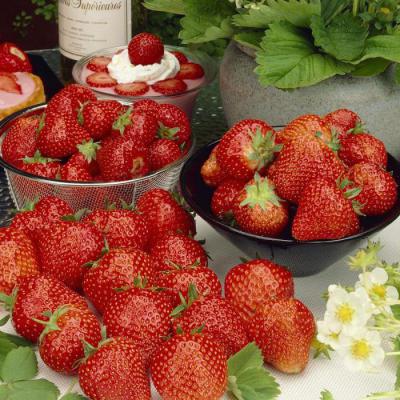

As soon as the strawberries begin to bear fruit, you need to reduce the frequency of watering - now it will be enough to do this every two weeks. Of course, if the soil suddenly turns out to be dry, it is simply necessary to give the desired moisture to the plant. By the way, the type of soil has a direct bearing on how intensively the berry will have to be watered.
It is recommended to water the strawberries from a watering can with a special nozzle, falling on the leaves - however, only until the flowers appear.And when the fruits are already harvested and the bushes are pruned, they should be moistened until the end of the season as needed.
Florence strawberries are quite capricious about the presence of dressings. She needs them in large quantities, because the more fertilizers, the larger the berry will turn out at the exit. At each season, certain additives should be made - so, in the spring, before flowering, nitrogen is best suited, but after the buds appear, you need to feed the strawberries with phosphorus and potassium. At the end of the season, the introduction of humus or manure will be most useful - this will help the roots of the plant to get stronger.
Gardeners reviews
Strawberries, or garden strawberries, varieties "Florina" do not grow smaller in the brushes, and there are very few mustaches on them, and the berries are tasty and fragrant. Florin grows on all types of soil, but yield is directly related to fertility. Best of all, according to gardeners, this variety grows on light and medium-textured soils with neutral acidity. Experienced gardeners advise, when preparing a plot, for each square meter, add 5-6 kg of organic matter and about 30-35 g of chlorine-free mineral fertilizers.
Reproduction
There are several ways to propagate Florence strawberries: antennae, dividing a bush or seeds. The first method - "mustache" - involves the selection of good, strong antennae, fixing them in the soil with a wire and, after the appearance of roots, planting in open ground.
Read also: Planting carrots in the Urals - terms
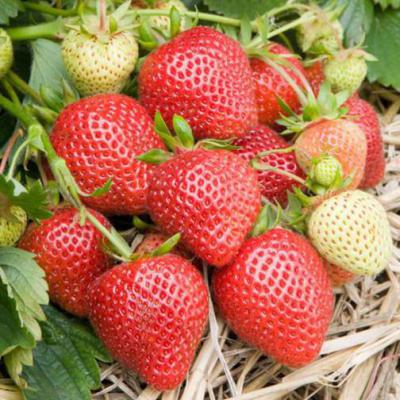

The division of the bush is also easy: you need to choose a plant that is at least three or four years old. Its root is divided into several parts, and separately each is sent to the soil. But reproduction by seeds is a more laborious process. It is necessary to obtain seeds from the elements of the skin and pulp of the berry. Then you should sow them on seedlings in a special soil, and only after a month - with abundant watering and good lighting - sprouts will sprout. When five or six leaves appear on the seedlings, you can send them into the open ground.
Watering
Florina, like other remontant varieties, needs more frequent watering than ordinary strawberries:
- Newly planted seedlings need to be watered daily (the first 4-5 days), then watering is done every other day, already matured seedlings are required no more than 1 time a week.
- Strawberry bushes planted last year are watered for the first time in the new season at the end of April. And from May to September, watering is carried out twice a month.
- If the summer is dry, there is no rain, then the soil should be moistened more often, as necessary, so that the soil does not dry out.
- The water should be warm. It is better to take rainwater, which is gradually collected in advance in a barrel.
- Morning and evening are the best times.
- To retain moisture in the soil, loosening or mulching is imperative. Sawdust, spruce or pine needles, straw, hay, humus can serve as mulch.


Reference! In addition to retaining moisture, the benefit of mulching is that it inhibits weed growth. Spunbond can be used as a protective coating.
Diseases and pests
Florence strawberries are susceptible to a disease called "gray rot", which occurs in the absence of ventilation and excess moisture. It is easy to recognize it: these are brown spots on fruits and leaves, as well as dry berries. It is permissible to fight gray rot with lime.
In addition, strawberries and powdery mildew are sick - at hot temperatures and excess moisture, spots of white dust appear on the leaves, and the berries begin to rot. To cure the berry, you will need treatment with milk whey with iodine and water. The third dangerous disease is verticillosis. The leaves become lethargic, fall off, their color changes from green to pink-yellow. Such a sore can affect strawberries if a lot of weeds appear next to it.
Growing strawberries of any kind, including Florence, is within the power of absolutely any summer resident.You just need to follow the simplest recommendations, and then a wonderful berry will fill your garden with aroma!
Description of the variety of strawberry florence
The new variety was bred by British breeders at an experimental station in East Mollingsk. Florence is characterized by a late fruiting period, high yield... The plant forms a vigorous, but not sprawling bush with a lot of whiskers.
Leaves are dark green glossy. Peduncles are extended above the level of the leaf, which makes it convenient to treat bushes from pests and diseases. The berries, according to the description, have a beautiful conical shape and a deep red color.
The plant develops normally both in greenhouse complexes and outdoors... The root system is resistant to various diseases. On berries, spots and fungus are extremely rare. The culture loves moderate heat, does not tolerate hot climates.
Frost resistance allows strawberries to be grown even in the northern regions. Tubers easily tolerate winter, you just have to properly prepare the garden for frost.
The beginning of the ripening of culture - from the second half of June to the end of July... The fruiting period depends on the care and climatic characteristics, on average it lasts 3-4 weeks. The yield on farms reaches 35 tons per hectare, which is about 1 kg per bush.
Characteristics of the variety
The bush is quite tall, powerful, densely covered with leaves. Due to the splendor, the bushes are spherical.
The plant forms a lot of whiskers. As the strawberries age, the assimilative form decreases significantly.
The leaves are large, dark green in color. Quite a lot of flowers are formed. Peduncles are long, strong, located above the level of the leaves, but, despite this, under the weight of the fruits they still fall on the ground.
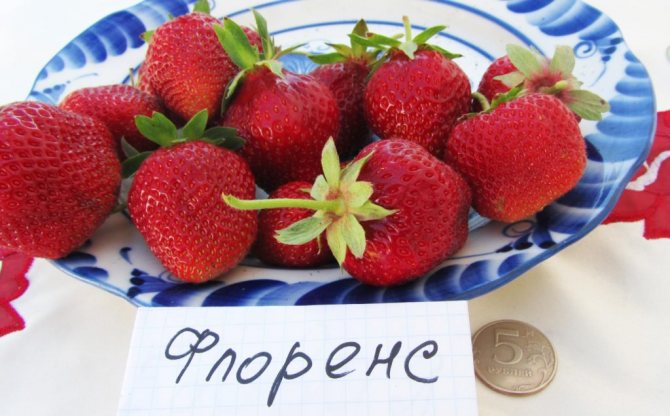

The berries of the Briton are large, wide-conical in shape. The red shell, when fully ripe, takes on a maroon hue. Yellow seeds are present on the surface of the shell.
The pulp is red, dense in structure, but not hard and does not crunch when biting the berry. The pulp is very juicy and has a pleasant, pronounced strawberry aroma.
The palatability of Florence strawberries is excellent. The berries are sweet, but not overkill. There is a hint of sourness, but it only complements the flavor palette. One of the main advantages of this variety is that, despite the weather conditions, be it the rainy season or too hot season, the berries still remain fragrant and tasty.
Berries have a universal purpose. They are suitable for fresh consumption, for processing (jam, jam, compote) and even for freezing.
Florence fruit is medium in size. Usually the weight of a ripe fruit is 30-40 grams. There are also specimens of 50-60 grams, but most often when grown on an industrial scale.
The yield of British strawberries is high. From 1 plant, you can easily collect up to 1 kg of marketable products, of course, if the growing conditions are suitable for the strawberries. At home, usually about 0.5-0.7 kg are collected from 1 bush.
As for the ripening period, these are late-ripening strawberries. On average, the ripening period for berries is early-mid July.
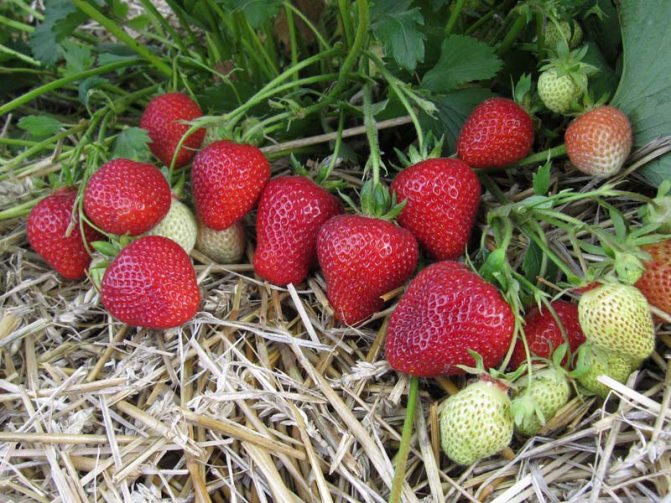

Characteristics of berries
The elite variety of strawberry florence differs from other representatives of strawberry by its beautiful cone-shaped large berry, the weight of which reaches 35-60 g... Delicate red pulp tastes sweet with a subtle hint of sourness.
The fruits can be eaten raw and after heat treatment (jam, preserves, confiture). Harvesting for the winter using freezing does not reduce the beneficial qualities of the berry.
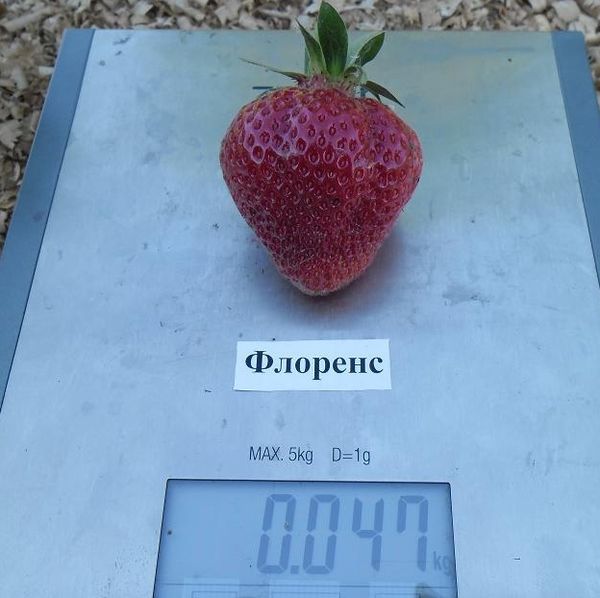

The average fruit weight is 35-60 grams
Florence is well preserved, does not lose presentability during transportation. Without mechanical stress or damage, it does not let the juice go.This allows farmers to deliver strawberries to distant regions without losing their presentation.
To keep the fruits for a long time, it is recommended to harvest in dry weather. after noon (in the evening).
Testimonials
Most of the reviews about the Dutch variety Florin are positive.
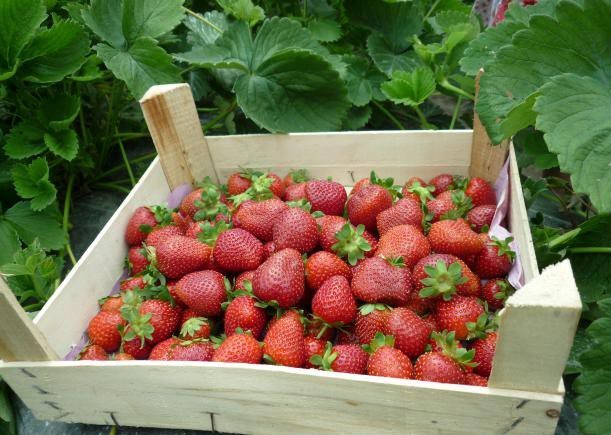

Gardeners love Florin's strawberries for their versatility, berries are good for fresh consumption and for harvesting for the winter.
These include points such as a long fruiting period, unpretentiousness, ease of reproduction, and disease resistance.
Some gardeners express dissatisfaction with the taste of berries with a pronounced acidity, but, according to the rest, the high yield of the variety more than covers this shortcoming.
Breeding history and growing region
The hybrid is obtained by crossing popular varieties Vima-Tarda and Vikodawhich makes a good pedigree. British breeders have worked for a long time on the development of high-yielding late-fruiting strawberries for industrial and dessert purposes.
One of the main goals was to achieve strong immunity. In 1997, their labors were crowned with success. The copyright holder is HRI East Malling.
On clayey areas, it is also possible to grow florence, but subject to timely fertilization of the soil (humus) and irrigation.
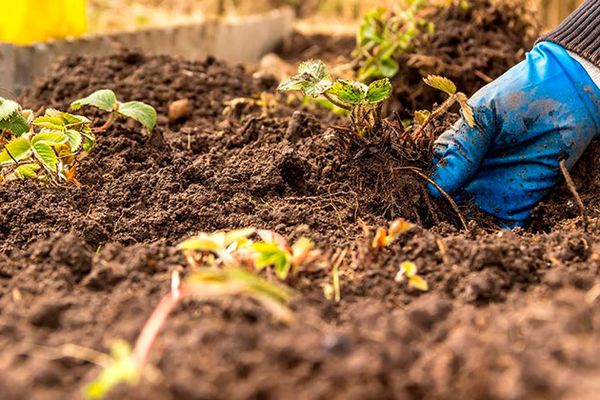

With timely fertilization, cultivation is possible on clay soils.
Advantages and disadvantages
Each variety has its own advantageous qualities and nuances of cultivation technology. To avoid unpleasant surprises when planting, nursing or picking strawberries, you should familiarize yourself with the pros and cons.
- does not require frequent updating of the beds, the bush retains its qualities in one place more than 5 years;
- berry of large size, beautiful regular shape and pronounced taste;
- keeps its presentation for a long time, easily transfers transportation;
- does not lose its properties when frozen;
- the culture is resistant to weather disasters (survives in the heat, with prolonged rains);
- versatility of the variety (suitable for growing in open ground and in greenhouse conditions);
- strawberries are resistant to many diseases.
- when landing, you need to observe some features;
- culture demanding on bait;
- frequent rains have a bad effect on the vegetative activity of the plant.
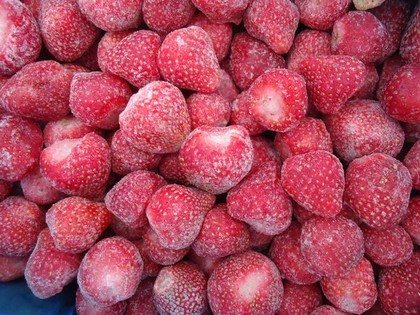

Strawberry florence does not lose its properties when frozen
Requirements for planting seedlings
It is better to choose young seedlings in separate pots... Such specimens with a closed root system quickly adapt to new conditions and take root.
You can plant tubers in spring and autumn, but the ideal time is the beginning of September, when there is still no frost at night. If the planting is carried out in the spring, then it is necessary to cover the bushes with geotextiles at night.
For strawberries, you need to choose a site on a hill so that groundwater and heavy rains do not provoke root rot.
The preparation of the beds begins with digging up the soil. It follows from it remove old roots and weeds as well as debris... Any strawberry variety loves nutritious soil, therefore, a month before planting, fertilizers (organic matter, mineral bait) are introduced into it.
Before planting, the surface of the site is crumbled dolomite flour for deoxidation. After processing, the land is settled for a couple of days. This is necessary to stabilize soil processes and enrich with nutrients.
The sizes of the formed bushes are considerable, therefore the holes are planned at a distance 30-35 cm apart.
In a prepared hole 10-15 cm deep, a small mound should be made and a seedling should be installed on it. The neck of the root should be flush with the ground. Mulch is laid on top around the bush. Planting ends with abundant watering.
Growing features
Since this hybrid is very picky about growing conditions, in order to obtain stable and high yields, the gardener needs to take care of proper care of the strawberry plantation. Care requirements include: proper planting, watering, feeding, shelter for the winter, protection from spring frosts during flowering, mulching, prevention of diseases and pests, and timely collection of fruits.
Read more on how to grow strawberries in winter.
Site selection and planting material
If the bed is located on fertile black soil, then as a preparation for planting plants, the soil must be loosened. If the soil is sandy and poor in organic matter, it should be fertilized with manure or compost (about 4-5 kg / m²). Before breaking up the garden, it is necessary to remove weeds., especially wheatgrass and other perennial creeping weeds. It is best to grow strawberries in the garden in a sunny place, on soil rich in humus, but light, even sandy, permeable to moisture and oxygen, slightly acidic (pH 5.5-6).
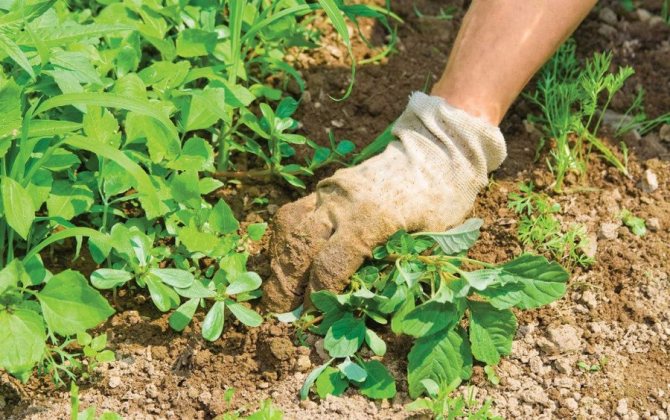

This crop will not grow well on heavy and wet soils. If the berries are grown in a lowland, then it is best to grow the crop in beds raised 15–20 cm above the ground so that water does not stagnate in the root zone of the plants. The best time to plant open-root seedlings is August-September.
Such seedlings will have time to fully take root before winter and will give a good harvest next year. If strawberries were planted in spring (April-May), then in the first year of cultivation, the gardener cannot count on a large number of berries. Strawberry bushes produce the best harvest in 2-3 years of growing season, therefore it is recommended to grow them in one place for only 3-4 years. Then strawberry seedlings should be planted in a new place.
Important! So that the strawberry conveyor is not interrupted due to the old age of the bushes, the gardener is advised to lay a new bed every 2 years. While young bushes adapt and grow on the new bed, the old bed will have time to grow old and finish fruiting.
Reproduction and planting
Until 20 years ago, strawberries were planted in spring or autumn. Today, thanks to advances in technology, strawberries can be planted throughout the growing season. You can buy not only green seedlings (dug out), but also frigo plants, as well as pot plants. Therefore, the time of planting and expected fruiting depends only on the type of strawberry seedlings.
Frigo seedlings - young strawberry plants are dug up in the fall and stored in refrigerated cabinets with a specially maintained temperature in the required range. Frigo can be both open and closed root systems. Differs in good survival rate and quick entry into the fruiting period.
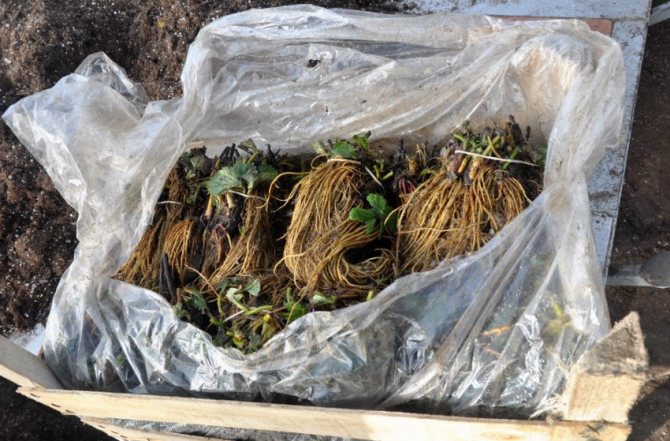

The relationship between the type of strawberry rosettes, the date of planting and the time of fruiting:
- Strawberries planted from traditional (excavated) seedlings in late autumn or spring, for the first time will only give a symbolic harvest. The maximum yield can be expected only in the second year and in subsequent years.
- Strawberries planted from frigo plants (planted from early spring to late June), gives the first harvest about 2 months after planting. The size of the yield depends on the thickness of the seedlings and the diameter of the crown (the thicker the seedlings, the higher the first yield). The next year, plants from frigo seedlings are already bearing fruit in the period typical for this variety.
- Potted plants usually planted from early July to autumn, and also in spring until late May. In this case, the first berries can be expected at a typical time for a given variety, while the yield will depend on the date of planting. From strawberries planted in spring or autumn, the first harvest, as in the case of seedlings (green), will be small. These plants will show full productivity only next year.Summer planting of potted seedlings shortens the waiting period for a real full harvest. Strawberries planted with potted seedlings in summer (July, August) will reach their peak fruiting next year. Quick adaptation is the undoubted advantage of potted plants, and this explains their growing popularity among gardeners.
On the one hand, I would like to plant the bushes as densely as possible, in the hope of a high yield. On the other hand, there is a reasonable limit on the number of plants per unit area, and over-compaction will cause individual plants to compete with each other for water and nutrients, and the ripened berries will be smaller and not as sweet as they could be.
Important! Wide paths between the rows will make it easier to care for strawberry bushes - weeding, watering, spraying against diseases and pests, as well as picking berries.
In addition, due to the high humidity in the areas of overly compacted plants, favorable conditions will be created for the development of various fungal infections, especially for gray mold. Experienced gardeners do not recommend planting more than 6 plants per square meter.
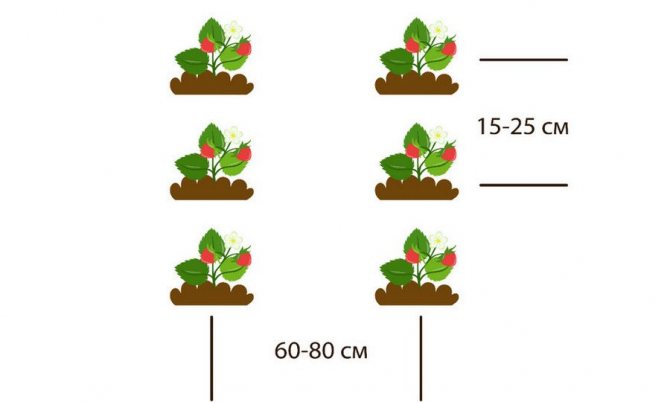

Strawberry planting scheme. Therefore, you can plant plants according to the scheme: 35 × 60 cm or 25 × 70 cm, or 20 × 80 cm.It should also be remembered that in the subsequent years of growing, despite the removal of whiskers and young rosettes, some part of young seedlings can always take root , which will increase the density of plants.
Watering
Strawberries, like any other plant, should be watered when the crop needs it. When growing berries outdoors - the frequency of watering depends on the weather. Strawberries need the most water after flowering and during strong growth and ripening (usually from late May to June). Lack of water during this period always leads to the fall of the berries and a strong decrease in the yield.
Of course, after the end of fruiting, there are also periods of drought. Therefore, the culture needs to provide soil moisture throughout the growing season, even in late autumn. It is worth remembering that all autumn, until the end of the growing season, is the time when flower buds are formed for the next year.
Care rules
It is not difficult to take care of the Florence variety; the plant does not require a special regime for itself. But there are still some nuances.
Watering should be regular with varying intensity for each stage of development.
Read also: Potato Galaxy: variety description, photos, reviews
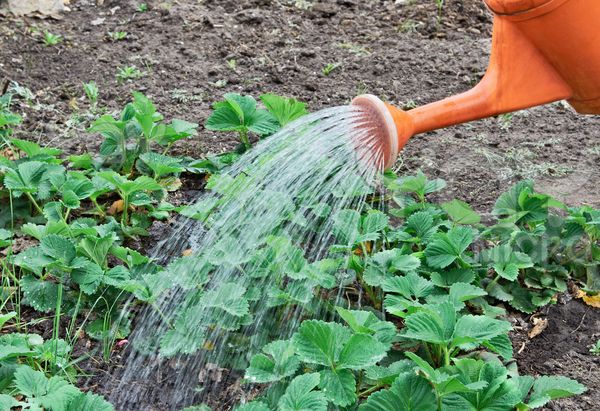

Watering florence strawberries
After planting, the seedlings are watered every 3 days... For 1m2, approximately 10 liters are required. After full adaptation, the interval between irrigations increases to 1 week. But it is worth adhering to the normative indicators in this matter.
Several factors affect the regularity of watering:
- soil type;
- weather;
- the presence of mulch or a special shelter made of agrofibre.
During the flowering period, moisture is especially necessary for the plant. And at the initial stage of fruiting, irrigation is reduced. It is enough to water the beds once a week, or even two. The condition of the soil should be checked periodically to keep it from drying out... With abundant watering during the ripening of the fruit, strawberries lose their taste.
After harvest, the cut bushes should be moderately moisturized until the end of the season. This will help the tubers survive the winter.
Irrigation of the florence variety is recommended by the method sprinkling or using the system drip irrigation.
For the normal development of the tuber, fertilizers should be introduced regularly... In the spring at the beginning of the season, it will be appropriate to use nitrogen, which improves the formation of the aboveground part. When buds and ovaries appear, it is time to introduce a bait based on phosphorus and potassium.
The season ends with feeding the soil with humus or fermented manure. So the roots will get stronger and gain strength before wintering.
Preparing for winter
One of the important stages of the preparatory work is considered hilling followed by laying mulch... You need to loosen the soil in early September, and you can mulch after a month.
A shelter made of agrofibre will help to survive the cold winter and temperature drops. It can be replaced by peat (straw), lined with a thick layer on top of shorn bushes. If the region is characterized by a warm climate, then there is no need for a protective layer.
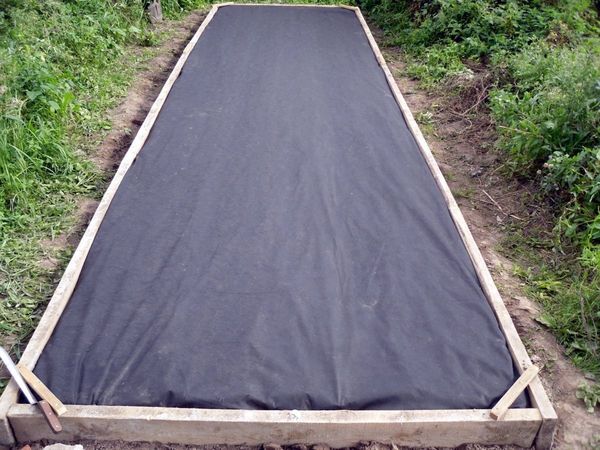

For the winter, florence strawberries must be covered with agrofibre
When processing the site, each bush should be examined in order to remove damaged branches or shoots.
Under favorable conditions, strawberry florence will bear fruit in the first season after the fall disembarkation... In the second year, the fruits will appear on the bushes, even if the development was accompanied by bad weather.
Harvesting and storage
This is undoubtedly the most enjoyable period in the entire growing process and the logical conclusion of the gardener's efforts. The first ripe strawberries are especially pleasing - long-awaited, large and very sweet. Strawberries should be picked regularly, ideally daily.
Do not delay the collection of fruits, so that there are no overripe berries on the bushes, which can easily become infected with gray mold and not only deteriorate themselves, but also become a source of infection for other, healthy fruits. The Florian hybrid has quite dense berries, but they still need to be collected in a shallow container with smooth walls. One container for collecting berries should hold no more than 0.5 kg of strawberries.
Did you know? Eating just 8 strawberries a day can improve heart health, lower blood pressure, reduce inflammation in the body, and even lower your risk of cancer.
Strawberries can be transported over long distances, but you need to do it quickly and only in specialized refrigerated vans (at a temperature of + 10 ... + 12 ° C). If the correct temperature regime is observed, the berries will remain fresh for 3-5 days. At home, strawberries can be stored in the refrigerator using a special drawer for berries and fruits.
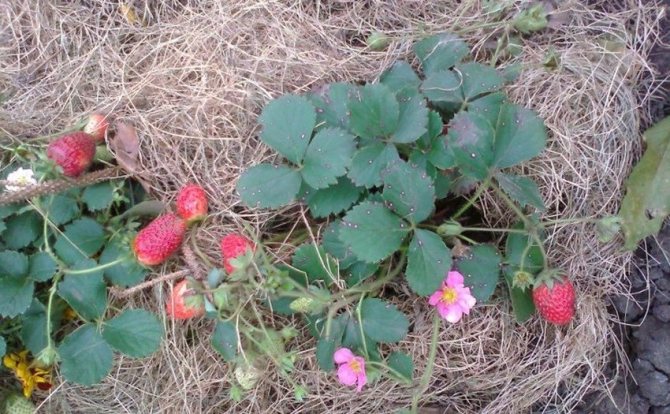

The garden strawberry (strawberry) of the Dutch hybrid Florian is popular among the gardener due to its large and aromatic berries. If the grower grows at least 50 bushes of varietal large-fruited strawberries, his family will be provided with fresh berries and fragrant jam for the winter.
Reproduction methods
Strawberries of the Florence variety reproduce in the usual ways typical of representatives of strawberries: by rooting a mustache, dividing a bush, and seeds.
Most often, gardeners use the vegetative method - daughter sockets... Selected quality whiskers are fixed in the soil with a bent wire or cut and placed in peat.
After 2-4 weeks, a root will appear, after which the shoot can be planted in open ground or in a separate pot.
Among the simple and affordable ways to propagate culture - dividing a bush... A healthy plant is selected that has reached 3-4 years of age. The root is cut into several parts and planted in a garden bed. The cut site is treated with ash or potassium permanganate solution. Clay dipping is also used.
Breeding method seeds longer and more time consuming. When using it, it is difficult to predict the quality of the seedlings obtained.
The bottom line is to dry the fragments of the skin with pulp for the subsequent production of seeds. Then they are sown along the grooves in a box with a substrate (soil + peat + humus) and moistened by spraying. The top of the container is covered with foil or glass.
When will it form on the shoots 2-3 leaves, you need to plant them in separate pots. When 5-6 leaves appear on the sprout, you can prepare seedlings for planting in open ground.
Diseases and pests
In general, florence strawberries are resistant to various diseases, but you should not relax.Under unfavorable conditions, the plant can get sick, which immediately becomes noticeable. by the changed appearance... You should not hesitate with treatment, otherwise the bush will die.
Verticilliasis
Verticilliasis is the most dangerous disease, capable of destroying most of the bushes.
The essence of the problem lies in the damage to the vascular system of the plant with dangerous spores. The bush sags in a short time, the leaves turn yellow and fall off. A dark ring forms on the root collar.
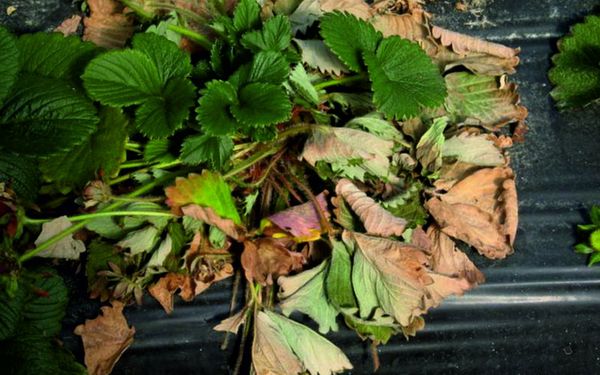

Verticillosis
After that, the beds are sprayed with a special solution. The following drugs are popular: Benorad, Fundazol. The disease can be prevented by treating seedlings before planting with a solution of potassium permanganate and periodically cleaning the beds from damaged branches and leaves.
Powdery mildew
Powdery mildew is formed due to the combination of warm temperatures and high humidity levels.
The foliage becomes covered with white dotted spots, similar to dust, the antennae die off, the berries begin to rot.
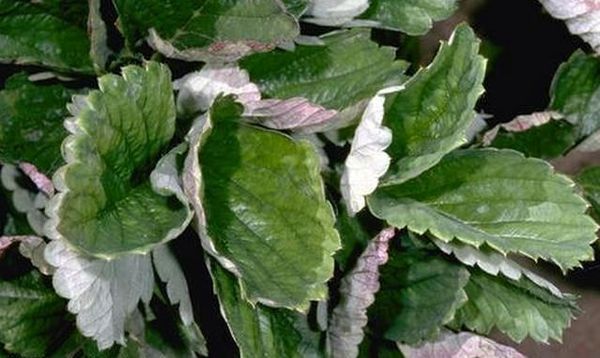

Powdery mildew
You need to start treatment with cleaning the garden from the affected parts bush. After that, the plants are sprayed with a solution of whey, water and iodine.
Also, special preparations can be used for processing. Prevention consists in moderate watering and maintaining the distance between the tubers.
Gray rot
Gray rot is characterized by the presence brown spots on foliage and fruits, drying of plants and berries. For treatment, it is recommended to treat plants with drugs: Fundazol, Teldor, Bayleton.
Some unpretentiousness of strawberries does not mean that it will bear fruit without proper care. But chores and labors will be rewarded with a bountiful harvest. Having tasted the English beauty once, it is impossible to forget the aftertaste.

